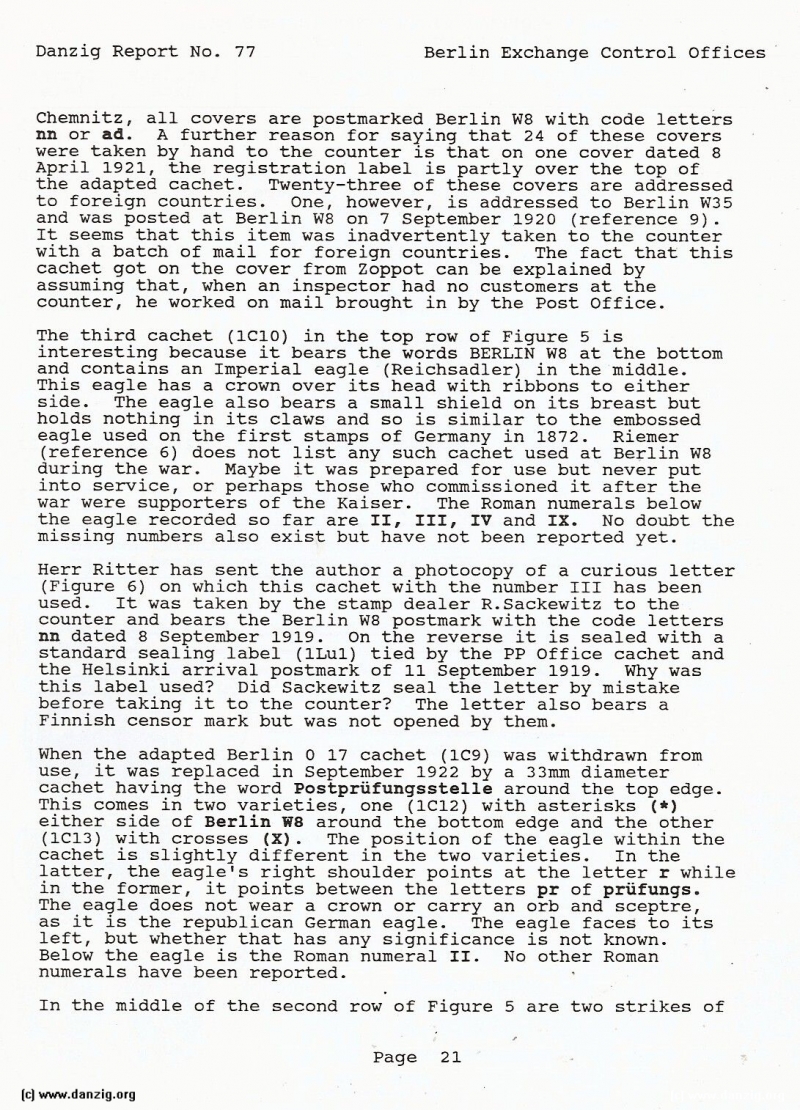
Chemnitz, all covers are postmarked Berlin W8 with code letters nn or ad. A further reason for saying that 24 of these covers were taken by hand to the counter is that on one cover dated 8 April 1921, the registration label is partly over the top of the adapted cachet. Twenty-three of these covers are addressed to foreign countries. One, however, is addressed to Berlin W35 and was posted at Berlin W8 on 7 September 1920 (reference 9). It seems that this item was inadvertently taken to the counter with a batch of mail for foreign countries. The fact that this cachet got on the cover from Zoppot can be explained by
assuming that, when an inspector had no customers at the counter, he worked on mail brought in by the Post Office.
The third cachet (lClO) in the top row of Figure 5 is interesting because it bears the words BERLIN W8 at the bottom and contains an Imperial eagle (Reichsadler) in the middle. This eagle has a crown over its head with ribbons to either side. The eagle also bears a small shield on its breast but holds nothing in its claws and so is similar to the embossed eagle used on the first stamps of Germany in 1872. Riexuer (reference 6) does not list any such cachet used at Berlin W8 during the war. Maybe it was prepared for use but never put into service, or perhaps those who commissioned it after the war were supporters of the Kaiser. The Roman numerals below the eagle recorded so far are II, III, IV and IX. No doubt the missing numbers also exist but have not been reported yet.
Herr Ritter has sent the author a photocopy of a curious letter (Figure 6) on which this cachet with the number III has been used. It was taken by the stamp dealer R.Sackewitz to the counter and bears the Berlin W8 postmark with the code letters nn dated 8 September 1919. On the reverse it is sealed with a standard sealing label (lLiil) tied by the PP Office cachet and the Helsinki arrival postmark of 11 September 1919. Why was this label used? Did Sackewitz seal the letter by mistake before taking it to the counter? The letter also bears a Finnish censor mark but was not opened by them.
When the adapted Berlin 0 17 cachet (1C9) was withdrawn from use, it was replaced in September 1922 by a 33mm diameter cachet having the word Postprüfungsstelle around the top edge. This comes in two varieties, one (1C12) with asterisks (*) either side of Berlin W8 around the bottom edge and the other (1C13) with crosses (X). The position of the eagle within the cachet is slightly different in the two varieties. In the latter, the eagle’s right shoulder points at the letter r while in the former, it points between the letters pr of prüfungs. The eagle does not wear a crown or carry an orb and sceptre, as it is the republican German eagle. The eagle faces to its left, but whether that has any significance is not known. Below the eagle is the Roman numeral II. No other Roman numerals have been reported.
In the middle of the second row of Figure 5 are two strikes of
Danzig Report Vol. 1 - Nr. 77 - October - November - December - 1992, Page 21.
Hits: 3276
Added: 03/07/2015
Copyright: 2025 Danzig.org

